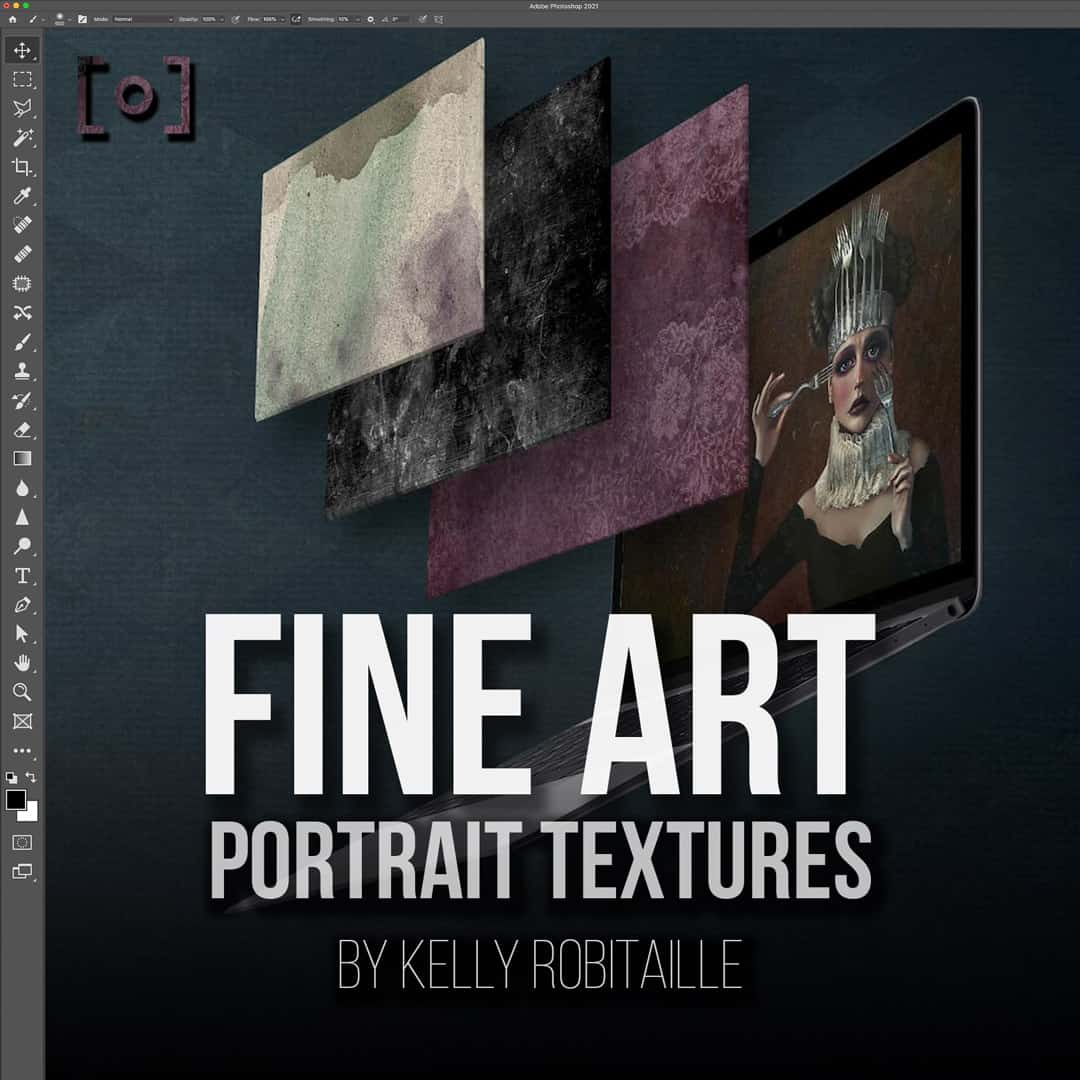Améliorations de texture : techniques pour des images photographiques éclatantes
En photographie, la texture joue un rôle essentiel pour ajouter de la profondeur et une dimension tactile aux images. En mettant l'accent sur la qualité de la surface du sujet, nous pouvons évoquer certaines émotions et raconter une histoire plus convaincante. Une surface rugueuse et écaillée peut transmettre une impression d'ancienneté et d'histoire, tandis qu'une texture lisse et brillante peut évoquer la modernité et l'élégance. Comprendre comment incorporer efficacement la texture dans nos images nous aide à transformer même le sujet le plus simple en un point focal captivant, attirant l'attention du spectateur et l'invitant à regarder de plus près.
Extrait du pack de textures Fine Art de Kelly Robitaille
Dans le monde de la photographie, nous savons que la texture n’est pas seulement un élément visuel, mais aussi une invitation à imaginer le sens du toucher. Notre défi en tant que photographes est de restituer cette expérience sensorielle à travers un support bidimensionnel. Maîtriser l’interaction entre la lumière et les ombres est crucial pour mettre en valeur les détails de texture de nos sujets. L’utilisation appropriée du matériel est tout aussi importante, du choix de l’objectif aux réglages de notre appareil photo. Savoir capturer l’essence de la texture peut faire toute la différence entre une photographie ordinaire et une photographie extraordinaire.
Principaux points à retenir
- Mettre l’accent sur la texture ajoute de la profondeur et de l’émotion aux photographies.
- Nous utilisons la lumière et les ombres pour mettre en valeur les détails de texture.
- Un équipement et des techniques appropriés sont essentiels pour la capture de texture.
Comprendre la texture en photographie
La texture en photographie permet d'ajouter de la profondeur et de l'attrait sensoriel, transformant les images en expériences qui nous engagent à plusieurs niveaux. Explorons la complexité des textures et leur influence sur la perception du spectateur.
Le rôle de la texture
La texture donne vie à une photographie, évoquant souvent des sensations tactiles et des réponses émotionnelles. Nous percevons la texture à travers les détails de la surface, comme la rugosité ou la douceur, qui sont capturés par l'interaction de la lumière et de l'ombre. L'essence de la texture réside dans sa capacité à suggérer la profondeur, créant une expérience plus immersive pour le spectateur. En mettant l'accent sur la texture, nous transformons une image bidimensionnelle en une scène qui semble tridimensionnelle et vivante.
Texture vs. Motif
Bien que la texture et le motif contribuent tous deux à l'intérêt visuel d'une image, ils n'ont pas le même objectif. La texture fait référence à la qualité de la surface qui peut être vue ou imaginée par le toucher, caractérisée par les détails tactiles qui donnent aux photographies une impression de physicalité. Le motif , en revanche, est un dessin répétitif de formes ou de lignes qui peut établir le rythme et la structure d'une image. Reconnaître cette distinction nous aide à améliorer nos compositions , en veillant à ce que les textures ajoutent de la profondeur sans être submergées par les motifs, qui peuvent parfois aplatir une image s'ils dominent le champ visuel.
Équipement essentiel
Pour capturer des images vibrantes et vivantes, les outils que nous utilisons sont aussi essentiels que notre œil artistique. Un équipement de précision peut grandement améliorer les textures en photographie, rehaussant ainsi le récit visuel.
Choisir le bon appareil photo et les bons objectifs
Lorsque nous choisissons un appareil photo, notre objectif est de sélectionner celui qui correspond à notre intention de mettre l'accent sur la texture. Pour obtenir des détails nets et des textures riches, un reflex numérique ou un appareil photo sans miroir avec des commandes manuelles pour la vitesse d'obturation et l'ouverture est idéal. Les objectifs font également une différence significative. Les objectifs à focale fixe sont généralement plus nets que les objectifs zoom, ce qui nous permet de capturer des textures détaillées, tandis qu'un objectif macro peut révéler des motifs complexes non visibles à l'œil nu.
-
Choix d'appareil photo
- DSLR : meilleur contrôle manuel, objectifs interchangeables
- Sans miroir : compact, tout aussi polyvalent dans le choix des objectifs
-
Types de lentilles
- Prime : Distance focale fixe ; netteté optimale
- Zoom : Distance focale variable ; cadrage flexible
- Macro : Photographie en gros plan ; capture de texture détaillée
Importance d'un trépied
Un trépied est un outil indispensable pour faire ressortir les textures des photos. Il offre une stabilité, réduit le tremblement de l'appareil photo et permet un cadrage précis, ce qui est essentiel lors de prises de vue à des vitesses d'obturation lentes pour capturer les détails fins. Pour les sujets texturés comme l'écorce d'un arbre ou le tissage d'un tissu, la netteté obtenue avec un trépied peut faire toute la différence.
-
Avantages du trépied
- Stabilisation : essentielle pour des images nettes
- Vitesses d'obturation lentes : permet des expositions plus longues sans flou
En associant le bon appareil photo et les bons objectifs à un trépied fiable, nous posons une base solide pour les améliorations de texture dans notre photographie.
Maîtriser la capture de texture
En photographie, les textures sont des éléments puissants qui donnent de la profondeur et de la dimension aux images. Nous verrons comment rechercher les bonnes textures et s'adapter à divers environnements pour obtenir la photo parfaite.
La recherche des textures
Lorsque nous recherchons des textures à photographier, nous recherchons essentiellement des détails qui amélioreront la qualité tactile de nos photos. Les surfaces rugueuses comme l'écorce des arbres ou la peinture écaillée sont idéales pour mettre en valeur la texture. En revanche, les surfaces lisses comme le verre ou le métal poli offrent leurs propres qualités de texture distinctes. Nous cherchons à trouver des contrastes qui captent la lumière, révèlent des motifs ou montrent des imperfections qui parlent aux sens du spectateur.
- Textures naturelles : Nous sommes entourés de textures dans la nature. Pensez aux lignes complexes sur une feuille ou aux ondulations du sable sur une plage. Ce sont ces nuances que nous recherchons.
Photographier des textures dans différents contextes
Maîtriser l’art de photographier les textures signifie s’adapter à différents environnements pour capturer leurs qualités uniques.
-
Textures extérieures : Les grands espaces sont un véritable trésor de textures naturelles . Il faut tenir compte de l'heure de la journée, car l'angle du soleil peut considérablement modifier l'apparence des textures. Le début de matinée ou la fin d'après-midi sont généralement idéaux pour projeter de longues ombres qui accentuent les textures.
-
Textures intérieures : Lorsque vous photographiez des textures en intérieur, l'éclairage artificiel peut être notre allié. En ajustant la direction et l'intensité des sources lumineuses, nous pouvons mettre en valeur la texture et la faire ressortir. Utilisez une grande ouverture pour garder la texture nette sur un arrière-plan flou.
N'oubliez pas que capturer une texture est autant une question de ressenti que de vision ; il s'agit d'inviter quelqu'un à imaginer la sensation du toucher à travers un support visuel.
Jeu d'ombre et de lumière
En photographie, la lumière et l'ombre sont bien plus que de simples aspects de l'exposition ; ce sont des outils dans notre arsenal artistique. Nous exploitons leur interaction pour apporter texture, profondeur et émotion à nos images, que nous gérons l'éclairage naturel ou que nous créions délibérément des ombres.
Travailler avec la lumière naturelle
Nous savons que travailler avec la lumière naturelle implique un certain degré de sérendipité, en particulier compte tenu de la variabilité des conditions météorologiques . La lumière naturelle peut aller de la douce lueur diffuse d'une journée nuageuse, que nous pourrions associer à des tons plus froids, aux contrastes saisissants créés par un soleil de midi. Dans Adobe Lightroom , le réglage de la balance des blancs peut renforcer la fraîcheur d'une photo prise un matin frais ou réchauffer une photo prise pendant l'heure dorée. Observez toujours la lumière naturelle qui nous entoure et anticipez ses variations, en fonction de l'heure de la journée et des conditions atmosphériques.
Créer de la profondeur avec les ombres
Les ombres sont nos partenaires silencieux pour créer une impression de tridimensionnalité. Lorsqu'elles sont utilisées efficacement, les ombres dures confèrent un poids visuel et une solidité aux sujets, les ancrant dans leur espace. À l'inverse, des ombres plus douces peuvent suggérer subtilité et profondeur sans dominer la scène. Dans Lightroom, nous jouons avec les curseurs « Ombres » et « Noirs » pour faire ressortir les détails cachés dans les zones les plus sombres, en veillant à ce qu'aucun élément essentiel ne s'efface dans l'obscurité. Notre objectif est de trouver un équilibre délicat, en créant une image où la lumière et l'ombre dansent en équilibre, sans que l'une ne submerge l'autre.
Techniques de post-traitement
Dans le domaine de la photographie, les techniques de post-traitement sont essentielles pour accentuer les textures, apporter de la profondeur et de la dimension aux images. Nous utilisons des outils et des méthodes d'édition puissants pour transformer de bonnes photos en de superbes photos avec une présence palpable.
Superposition et mélange de textures
L'utilisation de calques en post-traitement nous permet d'ajouter de la texture aux images de manière non destructive. Nous superposons de manière créative des textures sur la photo d'origine, en ajustant l' opacité pour contrôler l'intensité de l'effet. Grâce à un mélange minutieux à l'aide de modes de fusion , les textures interagissent avec l'image de base pour ajouter de la profondeur ou une sensation tactile.
- Modes de fusion : variété d'options telles que superposition, lumière douce, multiplication, etc.
- Masque de calque : utilisez-le pour masquer ou révéler des parties de la texture en fonction de l'image.
Exemple : si nous souhaitons améliorer l’aspect du métal rouillé, nous pouvons ajouter une couche de texture avec une image de rouille réelle, définir le mode de fusion sur « Multiplier », puis régler l’opacité à environ 50 % pour obtenir une apparence réaliste.
Amélioration des textures dans les logiciels de montage
Nous améliorons encore davantage les textures lors du post-traitement en utilisant les outils fournis par les logiciels d'édition haut de gamme. Les curseurs de netteté , les réglages de contraste et les fonctions de clarté sont nos options de prédilection pour faire ressortir les textures.
- Netteté : augmentez le contraste des bords pour rendre les textures plus prononcées.
- Contraste : ajustez pour amplifier la différence entre les zones claires et sombres, en accentuant la profondeur.
En appliquant ces ajustements de manière sélective avec un masque de calque , nous garantissons que les améliorations de texture se produisent exactement là où elles sont nécessaires, évitant ainsi un aspect uniformément sur-traité.
Les logiciels de retouche photo comme Adobe Lightroom et Photoshop offrent une gamme d'options sophistiquées pour le contrôle des textures qui peuvent être minutieusement affinées. En comprenant et en exploitant ces techniques, nous transformons des images plates en chefs-d'œuvre richement texturés.
Intégrer des textures dans divers types de photographie
Dans notre photographie, nous incorporons habilement des textures pour enrichir les récits visuels et rehausser l'attrait esthétique de nos images, qu'il s'agisse de portraits, de paysages ou de compositions de natures mortes.
Ajout de textures aux portraits
Les portraits gagnent en profondeur et en caractère lorsque nous intégrons des textures. Nous y parvenons en sélectionnant soigneusement des arrière-plans qui complètent le sujet. Un mur patiné ou un morceau de tissu aux motifs complexes peuvent ajouter une couche d'intérêt et attirer l'attention sur les traits de l'individu. En ajustant l'éclairage pour accentuer ces textures, nous réussissons à créer des portraits à la fois évocateurs et tangibles .
Textures dans la photographie de paysage
Avec la photographie de paysage , nous nous efforçons de capturer l'essence des textures de la nature. De la surface accidentée d'une montagne aux stries des formations rocheuses, chaque scène de paysage que nous choisissons regorge de textures potentielles. Notre technique consiste à exploiter la lumière naturelle, souvent pendant les heures dorées, pour projeter des ombres et des reflets qui révèlent les contours et les subtilités du terrain.
Nature morte et interaction des textures
La nature morte offre un environnement contrôlé où nous pouvons explorer l’interaction des textures. Ici, nous plaçons méticuleusement des objets aux textures diverses à proximité, en contrastant la céramique lisse avec le bois brut et vieilli ou en associant le verre brillant aux textiles mats. Grâce à cette interaction, nous construisons un dialogue visuel au sein de la nature morte qui fascine et engage le spectateur.
En appliquant ces pratiques riches en textures, nous apportons dimension et vie à nos œuvres photographiques à travers différents styles et sujets.
Applications créatives de textures
Lorsque nous parlons de texture en photographie, nous parlons d'un élément crucial qui ajoute de la profondeur et de la présence tactile à nos images. Une application appropriée peut transformer une photo ordinaire en une œuvre d'art évocatrice.
Créer de l'art textural abstrait
Dans la création d'art textural abstrait , nous combinons souvent des matériaux non conventionnels comme la peinture et l'huile avec notre pratique photographique. Notre objectif est de créer des images qui engagent les spectateurs au-delà du visuel, en les invitant à imaginer la texture avec leurs sens. Par exemple, l'application d'épaisses couches de peinture à l'huile sur une toile avant de la photographier peut donner des résultats tactiles époustouflants qui ressortent de l'image.
Textures dans la photographie artistique
La photographie artistique bénéficie grandement de l'incorporation de textures. Nous utilisons des textures pour attirer l'attention sur les qualités inhérentes du sujet, comme la rugosité d'un vieux mur de briques ou les traits délicats d'une peinture à l'huile . En ajustant les paramètres de notre appareil photo, nous pouvons mettre en valeur les textures, donnant aux photos artistiques une présence qui résonne auprès de l'observateur. Il ne s'agit pas simplement de capturer une image ; il s'agit d'immortaliser le caractère et l'essence de nos sujets.
Conseils techniques pour les améliorations de texture
Dans notre quête pour donner vie à vos photos grâce à des améliorations de texture, nous partagerons des méthodologies éprouvées qui produisent des résultats remarquables. Une manipulation précise des textures peut rehausser une histoire, transformant une image simple en un récit visuel articulé.
Éviter le bougé de l'appareil photo
Pour garantir l'intégrité de la texture de vos photos, il est primordial de stabiliser votre appareil photo . Évitez les tremblements de l'appareil photo en :
- Utiliser un trépied : c'est indispensable lorsque l'on travaille dans des conditions de faible luminosité ou avec de longues expositions.
- Règle de vitesse d'obturation : en règle générale, votre vitesse d'obturation doit être l'inverse de votre distance focale. Par exemple, à 50 mm, visez au moins 1/50e de seconde pour réduire le flou.
Utilisation de masques et de curseurs pour plus de précision
Nous améliorons nos textures en maniant les masques et les curseurs avec précision. Notre tutoriel comprend :
- Masques de calque : utilisez des masques de calque pour isoler les zones de texture, en veillant à ce que les améliorations n'affectent que les zones souhaitées.
- Curseurs de réglage : ajustez le contraste, la clarté et la netteté avec des curseurs pour faire ressortir les subtilités de la texture, en élaborant le récit pièce par pièce.
Questions fréquemment posées
Dans cette section, nous aborderons les questions courantes concernant l'affinement des détails texturaux des photographies, en abordant à la fois les techniques manuelles et les aides technologiques.
Quelles options logicielles sont disponibles pour améliorer les textures des images ?
Nous recommandons souvent des logiciels de qualité professionnelle tels qu'Adobe Photoshop pour ses outils avancés d'amélioration de texture. Pour se concentrer sur les améliorations basées sur l'IA, des logiciels comme Topaz Labs proposent des algorithmes spécialisés pour affiner et définir les textures.
Quelles techniques les professionnels utilisent-ils pour améliorer la texture de leurs photos ?
Les professionnels améliorent la texture à l'aide d'un éclairage contrôlé et d'un post-traitement précis. L'éclairage directionnel peut accentuer la texture, et des outils tels que les réglages de netteté, de clarté et de contraste dans les logiciels de post-traitement sont essentiels pour faire ressortir les textures.
La technologie de l’IA peut-elle aider à flouter et à améliorer les détails d’une image ?
Oui, la technologie de l'IA peut considérablement contribuer à cet aspect. En analysant les motifs et la structure d'une image, les outilsd'amélioration basés sur l'IA peuvent réduire le flou et clarifier les détails , ce qui donne à l'image un aspect plus net et plus texturé.
Comment puis-je améliorer une photo tout en conservant sa qualité ?
La mise à l'échelle des photos tout en préservant la qualité est obtenue à l'aide d'un logiciel qui applique un rééchantillonnage intelligent ou des améliorations d'IA. Le processus de mise à l'échelle consiste à augmenter la résolution tout en minimisant la perte de détails et en évitant la pixellisation.
Quels sont les avantages de l’utilisation de la texture dans la composition photographique ?
La texture ajoute de la profondeur et de la dimension aux photos, les rendant plus attrayantes et réalistes. L'intégration de textures peut conduire à une expérience plus tactile et permet de transmettre l'histoire complète de votre sujet.
Comment l’ajout de texture à une photo affecte-t-il son impact visuel ?
L'ajout de texture peut considérablement augmenter l' impact visuel d'une photo en créant un sentiment de présence et de matérialité. Les textures attirent le regard des spectateurs, offrant une expérience visuelle plus riche et contribuant à l'attrait esthétique global de l'image.














